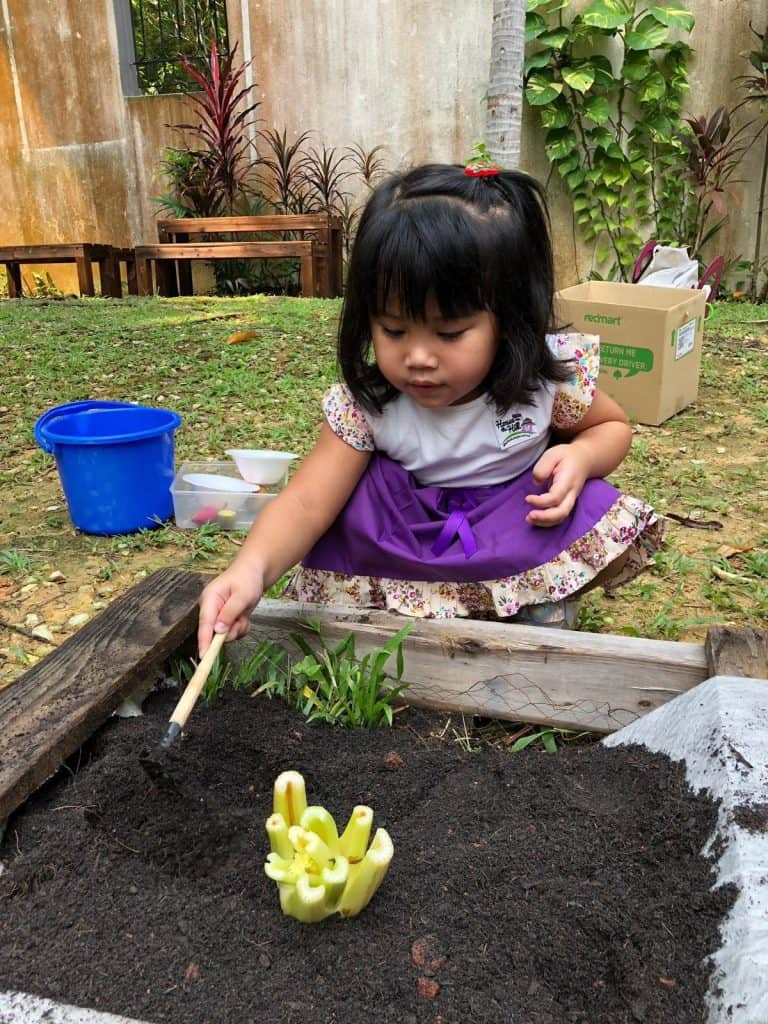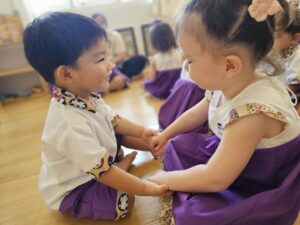Six Essential Skills for Children’s Positive Development
by Nurul Fitton
Montessori does not always mean specific materials found in our classrooms. Much of it comes down to a central philosophy and an awareness within our educators, to create meaningful, holistic experiences that help our children to better engage their curiosity and develop their senses..
A Montessori education places much stock on “holistic education” – in other words, the holistic development of the emotional, artistic, creative and academic aspects of a child’s life. This approach nurtures the growth of all the different areas of a child’s mind, in an attractive as well as natural way. We aim to enable children to make the greatest possible use of their academic learning as a tool for social and emotional growth.
Our Montessori-led curriculum thus focuses on developing the six essential skills to children’s positive development. This helps our students to be engaged with all facets of learning, emerging as confident, joyful, independent young people, full of curiosity and a love of learning.
Here are the six essential skills that the Montessori method helps to nurture, and how that in turn develops growth in a holistic fashion.
1. The child as a spontaneous observer of nature
“Only through freedom and environmental experience is it practically possible for human development to occur.” – Dr Maria Montessori

Children are instinctively attracted to plants! At House on the Hill we bring children to nature, and bring nature to the children. We aim for a balance of free play and Montessori inspired activities that help children care for and learn about their environment.

For example, we set flower pots made of recycled bottles all around our compounds. The children never forget to water the plants with their little watering cans. Very often, we notice that they are silent and peaceful, completely absorbed in contemplation.
Spending time in an outdoor environment is vital to the development of the whole child. Not only is it a natural extension of the study of botany in the classroom, but playing and learning outdoors promotes physical, social, emotional, and cognitive development. We use our time in nature to encourage a connection to it. We discuss how to care for it and how to be environmentally responsible.
2. The child as a lover of all living beings
“Children have an anxious concern for living beings, and the satisfaction of this instinct fills them with delight.” – Dr Maria Montessori
All children have innate concern for living beings, and the satisfaction of this instinct fills them with delight. They are filled with feelings of tenderness and enthusiasm, and the desire to care for these beings.
Helping to care for a furry or scaly class pet is a fun and an exciting exercise for children in HotH. We have adopted a number of animals over the years. Aside from being an extension of the learning of zoology, a class pet teaches the children important values such as compassion, empathy, respect, and responsibility for other living things. We nurture leadership and character building through caring for our hamsters, terrapins or even stick insects in the classroom.
In the picture below, the child was so struck by the changes undergone by the little hamster that she could describe its development, reporting its growth like a miniature zoologist.

It is never too early to learn to care for the needs of other living beings. Whether they are helping to empty the water in a terrapin’s tank, or feeding the stick insects with some mulberry leaves, our children learn to be responsible and develop strong human-animal bonds. These relationships also help to strengthen a child’s social skills, giving them the potential to do better in a school setting. Social & emotional development begins at a very young age — these skills help to guide our emotions and feel empathy, as well as building healthy relationships. It helps children to recognise if someone is sad, and ask if they are okay; helps them with understanding their thoughts and feelings, and develops their ability to relate to others.
*Do note that all child-animal interactions are supervised.
3. The child as an explorer of endless discoveries
“We especially need imagination in science. It is not all mathematics, nor all logic, but it is somewhat beauty and poetry”. – Dr Maria Montessori
Children love to experiment independently. We use activities such as engaging in hands-on science activities to develop curiosity, observation and focus, as well as the cognitive skills of sorting, learning to classify and motor skill development.
When children engage freely in science activities, they begin to realize that some experiments will work while others do not. This is a critical learning process. A child who is constantly testing new objects may be ready to move on to more challenging task.

Trial and error is important when learning science. In the picture, the child is observing diligently, focusing on the experiment that she has just conducted. What worked? What didn’t work? How could I do it differently next time?

The world is a fascinating place and we want our students to hone and maintain a sense of curiosity, learning step-by-step ways to play, discover, explore – and conquer!
4. The child as an advocate of cultural diversity
“Culture and education have no bounds or limits.” – Dr Maria Montessori
The Montessori curriculum supports an understanding of the cultural diversity of the world. One of the ways we support this is when we observe festivals of the diverse cultural practices of those who make our community. Instead of beginning with a particular festive celebration, we build on the children’s imaginative powers and begin the lesson with stories that explore the traditions and practices of the individual ethnic group. These stories create a framework of detailed information, and extend into more specific lessons of explorations and research. It is our priority to support cultural diversity, by exposing the children to as many other cultures and practices as possible.

Here in this Lunar New Year observance (photo above), the teacher guides the children by giving presentations that demonstrate how to use the activities. The children engage with them based on the work that meets their individual ability level. For such observances, the children will sing songs, taste the foods and experience different aspects of the festivities. We will usually invite students celebrating the festival to share about their experiences, and very often, parents will contribute with homemade food or a related item. We hope that we’ll be able to invite parents back into school to share in person soon! This broad range of activities increases each child’s experiences of, and respect for, diversity.
5. The child as an active body
“Movement helps the development of the mind, and this finds renewed expression in further movement and activity”. – Maria Montessori.
Much focus is given in the areas of fine motor that at times we tend to overlook the importance of gross motor skills, which is the development and coordination of large muscles and movements.
In a Montessori curriculum, there is a lot of emphasis on motor skill development – both fine and gross. Gross motor skills refer to the development and coordination of large muscles and movements. In the classroom, working on these skills include movement around the room, moving chairs, walking, lifting and practical life activities like wiping tables or washing their bowls. Children need the freedom to move and at HotH, we support such freedom by providing time for them to get outside and exert their energy. To run until they can’t run any more, to laugh and to chase each other! To be free and just let it all out!

Running, skipping, riding a bike or climbing at a playground – using all those gross motor skills are just as important as taking a tray off the shelves and working at a desk. Life skills, risk taking, fun, physical exertion, problem solving, critical thinking can all come from gross motor play. Gross motor work also lays the foundation for the use of fine motor skills.
6. The child as a master of creation
“Imagination does not become great until human beings, given the courage and strength, use it to create.” – Maria Montessori
Art & Crafts are integrated in our Montessori classrooms as a form of communication in non-linguistic modes. We want to create an environment where our children develop the ability to create meaning. This we achieve through repeated opportunities both to internalise this feeling, as well as to express it. The arts allow for purposeful meaning-making. When children integrate social, emotional, physical and intellectual understanding through the creation or experience of art, that understanding is made more personal, more responsive and more lasting.

Art experiences also provide opportunities for children to collaborate while working in groups and build relationships, confidence, discipline, persistence and self-reward. It allows children to think creatively and critically, observing and documenting patterns, shapes and forms.
At House on the Hill, we stay true to the values and educational excellence of the Montessori Method. Thankfully, Dr. Maria Montessori gave us a framework to aid us in our work, giving us all the tools we need to be active guides in our children’s development.








